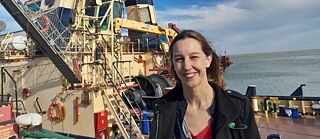Argentinian poet Lucía Bianco is the director of the Port Museum in Ingeniero White, a town near the city of Bahía Blanca. Both in her verses and in her role at the museum, Lucía covers stories of the estuary and the sea.
“I was born in 1979 in Punta Alta,“ a town near Bahía Blanca, which is the headquarters of a naval base. “I grew up playing in museums, because my mom is a geologist. She and my dad were collectors, and they established the first Municipal Museum of Natural Sciences in Punta Alta. Darwin—that area was inspirational for his theory of evolution—, and geology were part of the stories he used to listen to before going to sleep.“
The sun caresses the port’s promenade, with its gastronomic establishments and the image of the patron saint of fishermen, San Silverio. Growing up in Punta Alta allowed her to “spend afternoons on a beach, not made of sand, but mud. With crabs and seagulls. Where you see ships passing by that set sail in White.“
That “estuary which is so difficult to understand“ inspired Lucía to write her most recent collection of poems, Paleo río (N Direcciones): “Ten thousand years, a river (the Colorado) that is not there and yet, there are things that continue to exist and that make me me, a small individual.“ Lucía walks through the port and notices that there are almost no artisanal fisherman left anymore. Only the old boats as silent witnesses, hoping to be repaired after a storm.
Another of her books of poems is titled Preinsectario. Lucía says that in the Bahía Blanca estuary having an “alert sense of smell“ is crucial “because, with the tides, the port changes quite a lot. If the water level decreases, if there is a south wind, or if there is a north wind, the scents change. There are days when you smell algae or mud. Some when you smell grain, because they are export ports. And other days, something related to the petrochemical port.“
At the same time, “the screaming of the seagulls“ predominate as they fly above the ocean in grey and brown tones.“ I cannot really imagine living anywhere else,“ says the first woman director of the Port Museum of Ingeniero White as the wind blows the flags of anchored ships. “These kinds of horizons, scents, what visually suggests distance…“
Bianco lives in a working-class neighborhood in Bahía Blanca, a city that is the gateway to Argentine Patagonia. Beyond the diverse origins of Punta Alta and Ingeniero White—places in the south of the province of Buenos Aires, about 30 kilometers away from one another—, Lucía finds similarities such as “the immigrant neighborhoods of Italians, Greeks, and Croats. Their migration stories resonate with those of so many other people. It is not a single story; quite the opposite.“ That experience led her to compose the poem, “Paleo río,“ which goes like this:
“… Who does not have a great-grandfather from the group of carpenters
who built the dry dock, for example.
Or someone who is a farmer, a seamstress, or a baker.
Or else, who was born in Yugoslavia or an anarchist or a union leader
or all three at once.
Who does not have something they have forgotten, but that deep down they recognize
when they touch the wood of a century-old door and suddenly
it makes them want to cry, ever so softly.“
That century-old wood could very well belong to the Port Museum of Ingeniero White, which operates in a former Customs shelter built by an English company in 1907.
The afternoon descends on the neighborhood whose houses are made of metal and wood. The chocolate at the Association of Friends delights those visiting the Museum and the Murga Vía Libre Center. Every Sunday, different groups or various chefs in the neighborhood prepare their dishes to the sounds of live popular music. This time, beneath the banners, they share tables and applaud enthusiastically. One woman confesses quietly: “I have never seen street musicians playing live.“
The Port Museum was established in 1987 and Bianco, a graduate of the School of Visual Arts of Bahía Blanca, has directed it since 2019. Prior to that, she worked in the kitchen, researching that “area of specific knowledge that has been discredited for years. The port does not move if no one is cooking. That thought drives the museum.“
For the Bathing Room, the last to be staged, “we got into taboo topics over time, such as the changes in women’s bodies, violence, and disagreements in the port.“ The picturesque collection of objects in the colorful rooms was assembled through donations. This collection and the museum’s oral, photographic and documentary archives offer a rich image of townsfolk life.
Bianco is proud of the oral archive, with over a thousand voices of workers, cooks and artisanal fishermen. “When we set up a room, the first thing we do, in addition to gathering documents and reviewing files, is conduct interviews about the topic we want to focus on. Listening allows you to understand that there are many versions of every story.“
